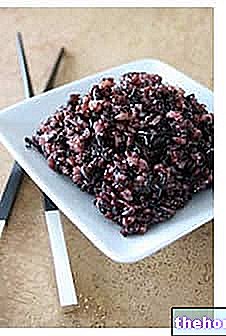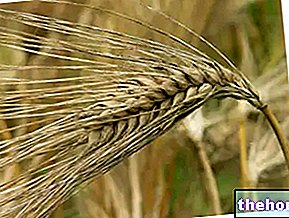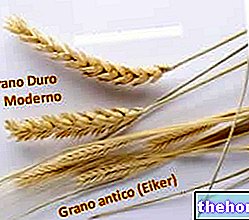
They are traditionally used at breakfast or in secondary snacks between main meals - mid-morning and / or mid-afternoon or even before sleep.
There are various types of rusks, different in shape - round or square - taste and flavor - normal, sweet rusks, malt or cocoa rusks etc. - and composition - traditional, wholemeal rusks, rice or other cereals, gluten-free rusks / gluten-free rusks, salt-free / low-sodium rusks, etc.
Unlike ordinary bread, rusks have a completely crunchy texture. They lend themselves to accompanying sweet and savory foods, or to be soaked.
From a nutritional point of view, compared to bread, rusks contain less water and more calories; moreover, they have a higher concentration of maltodextrins and simple / soluble sugars - also sucrose - and therefore a decidedly sweeter taste. In more restrictive diets, rusks are frequently used alone, as if they were biscuits, rather than as a substitute for bread - with respect to which they have less valuable nutritional characteristics.
Rusks are mainly commercial foods; nevertheless, they can also be produced at home. Below we will propose a recipe to make them at home.
, from the very low humidity and the presence of fats - mainly unsaturated - necessary for the dough and browning. They also contain a modest quantity of proteins of medium biological value and a fair concentration of dietary fiber.
Compared to common bread, the starchy polymers and the proteins of the rusks, undergoing a double cooking, undergo thermal hydrolysis favoring the reduction of digestive times; this characteristic also determines an increase in the glycemic-insulin index.
Rusks contain gluten; some also show small concentrations of lactose, while the histamine level is negligible. The purine content is low, while the phenylalanine intake seems to be of medium entity. Cholesterol is absent.
The rusks contain good amounts of iron - even if not very bioavailable - sodium - of table salt - potassium, magnesium and zinc. The contribution of water-soluble vitamins of group B is important - especially thiamine or B1, riboflavin or B2 and niacin or PP.

Rusks are not a complete protein source. The biological value, of medium entity - it does not contain all the essential amino acids for man in the right quantities and proportions - requires to be compensated by taking food sources that contain the so-called limiting amino acids. Among these - not necessarily to be taken in the same meal - we can include all foods of animal origin, certain legumes or other seeds and seaweeds. The currently produced rusks have an adequate lipid profile - absence of cholesterol and prevalence of unsaturated over saturated fatty acids, with a good amount of polyunsaturated fatty acids - even for those suffering from hypercholesterolemia.
The fair amount of iron, even if not bioavailable, makes rusks a preferable food compared to many others in the same category and poorer in the mineral. However, they cannot replace elite food sources such as meat, fish and eggs - necessary to prevent-cure iron deficiency anemia, more frequent in fertile women, pregnant women, etc. The good content of potassium and magnesium helps to cover the needs specific nutritional value of these alkalizing minerals and necessary for the transmission of the neuro-muscular action potential; in the organism they decrease with the increase of sweating and with the fecal-urinary losses. Zinc is essential for building antioxidant enzymes and maintaining thyroid health. B vitamins play the role of coenzymes. The rusks are not an exclusive food source but participate in the achievement of the recommended ration, partially supporting the efficiency of all tissues.
Rusks do not lend themselves to the celiac's diet. If they are free of milk and derivatives, they are suitable for nutritional therapy against lactose intolerance and allergy to milk proteins. They can be used in the diet against hyperuricemia, histamine intolerance and phenylketonuria.
Being considered of good digestibility, rusks are sometimes recommended in the dietary therapy of those suffering from digestive disorders, for example: stomach acid, hiatal hernia and gastroesophageal reflux disease, gastritis and gastric or duodenal peptic ulcer.
They are all suitable for the vegetarian philosophy, while only those free of milk and derivatives, eggs and derivatives and fats of animal origin lend themselves to the vegan diet. The relevance to religious diets is to be analyzed case by case, observing the list of ingredients.
, jam, jam, jelly, spreadable cream with hazelnuts such as Nutella, peanut butter, condensed milk, etc. - but also savory - robiola, crescenza, squacquerone, certosa, stracchino, ricotta, philadelphia type, anchovy paste, sauces such as mayonnaise or mustard etc .; it is not uncommon that they replace slices of bread also to accompany vegetables, meat, fish , eggs, hard cheeses such as Grana Padano, Parmigiano Reggiano and Pecorino, and cured meats such as raw ham, cooked ham, salami, mortadella, pancetta, coppa, etc. - they are not suitable for collecting sauces and condiments, that is to say "scarpetta". They are also extremely suitable for soaking in milk, fruit juices and juices..
Commercial Rusk Recipes
The ingredients of COMMERCIAL rusks are: type 00 soft wheat flour, palm oil, brewer's yeast, sugar, barley malt extract, "malted" wheat flour and salt; obviously, each company has a different recipe but In principle, the ingredients do not differ much from those mentioned - with the exception of dietetic products.
Process of commercial rusks
The process is totally automated and involves a packaging that guarantees the maintenance of the organoleptic and taste characteristics of the rusks for a rather long period.
Homemade rusks recipes
Rusks are foods that can be easily reproduced even at home; the ingredients of the homemade rusks are: soft wheat flour, butter, brewer's yeast, sugar, eggs, milk, water and salt (milk and eggs can be replaced by other water but the result cannot be superimposed).
Process of homemade rusks
The preparation takes place in the following way: sift the flours; dissolve the yeast in a little water and add it to the flour; add the rest of the water, the milk, the sugar and the eggs, and knead; then, add the salt and the softened butter while continuing to knead; let it rise until it reaches double the initial volume; break the leavening by flattening the dough and rolling it up on itself; put it in a loaf tin lined with baking paper and let it rise again; brush with eggs or milk; bake and bake at 180 ° C for 40 "; take it out of the mold and let it cool; cut slices of about one centimeter and place them on a baking sheet; bake in a ventilated oven at 130 ° for 45"; allow to cool and consume.
Homemade Rusks
Problems with playing the video? Reload the video from youtube.
- Go to the Video Page
- Go to the Video Recipes Section
- Watch the video on youtube









.jpg)


















